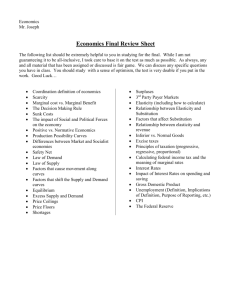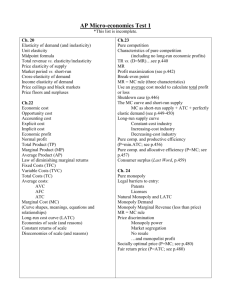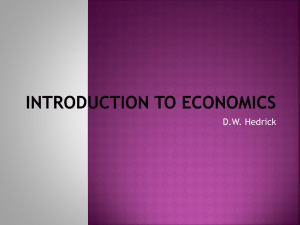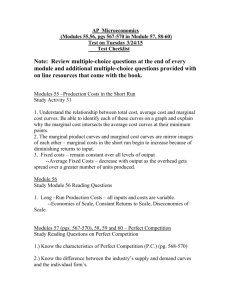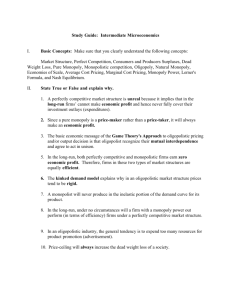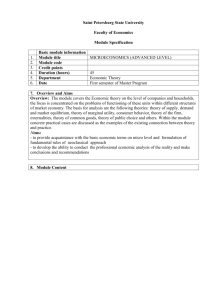ECO 251 PRINCIPLES OF MICROECONOMICS COURSE
advertisement
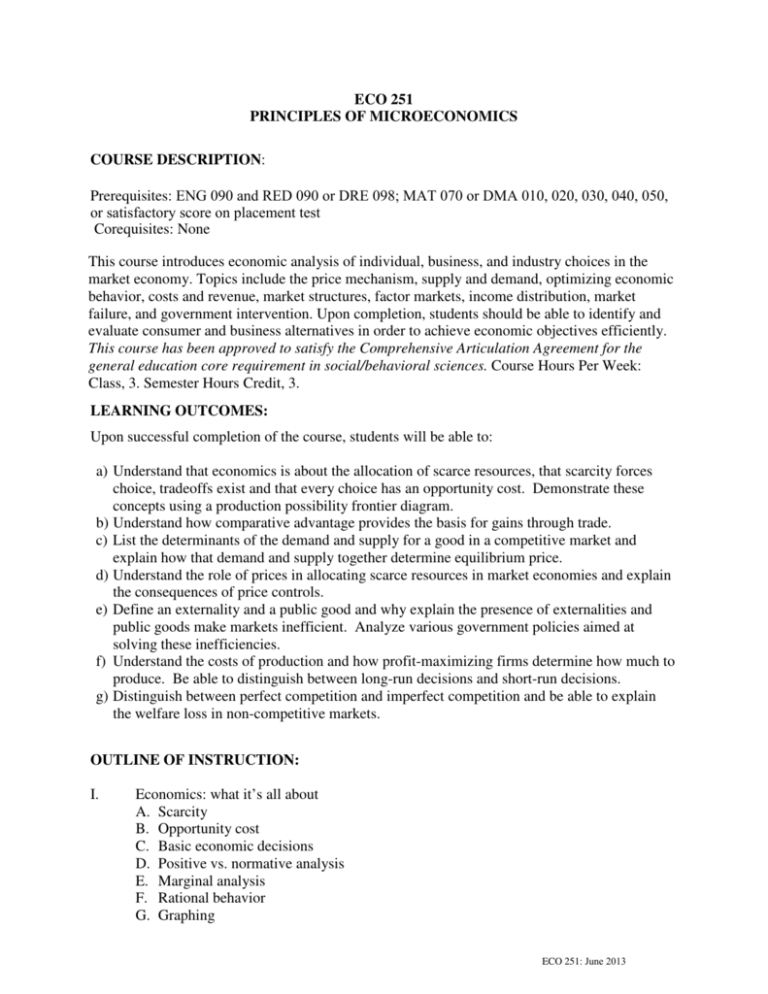
ECO 251 PRINCIPLES OF MICROECONOMICS COURSE DESCRIPTION: Prerequisites: ENG 090 and RED 090 or DRE 098; MAT 070 or DMA 010, 020, 030, 040, 050, or satisfactory score on placement test Corequisites: None This course introduces economic analysis of individual, business, and industry choices in the market economy. Topics include the price mechanism, supply and demand, optimizing economic behavior, costs and revenue, market structures, factor markets, income distribution, market failure, and government intervention. Upon completion, students should be able to identify and evaluate consumer and business alternatives in order to achieve economic objectives efficiently. This course has been approved to satisfy the Comprehensive Articulation Agreement for the general education core requirement in social/behavioral sciences. Course Hours Per Week: Class, 3. Semester Hours Credit, 3. LEARNING OUTCOMES: Upon successful completion of the course, students will be able to: a) Understand that economics is about the allocation of scarce resources, that scarcity forces choice, tradeoffs exist and that every choice has an opportunity cost. Demonstrate these concepts using a production possibility frontier diagram. b) Understand how comparative advantage provides the basis for gains through trade. c) List the determinants of the demand and supply for a good in a competitive market and explain how that demand and supply together determine equilibrium price. d) Understand the role of prices in allocating scarce resources in market economies and explain the consequences of price controls. e) Define an externality and a public good and why explain the presence of externalities and public goods make markets inefficient. Analyze various government policies aimed at solving these inefficiencies. f) Understand the costs of production and how profit-maximizing firms determine how much to produce. Be able to distinguish between long-run decisions and short-run decisions. g) Distinguish between perfect competition and imperfect competition and be able to explain the welfare loss in non-competitive markets. OUTLINE OF INSTRUCTION: I. Economics: what it’s all about A. Scarcity B. Opportunity cost C. Basic economic decisions D. Positive vs. normative analysis E. Marginal analysis F. Rational behavior G. Graphing ECO 251: June 2013 II. Production possibilities A. Resources, technology and production possibilities B. Production possibilities curve C. Expanding production possibilities III. Supply and demand analysis A. Demand B. The law of demand and the market demand curve C. Supply D. The law of supply and the market supply curve E. Market equilibrium, price and quantity F. Prices and scarcity G. Markets for labor and credit H. Price ceilings, floors and controls IV. The price system and the mixed economy A. Capitalism and the market economy B. How the price system works C. Common defects in the price system D. The modern mixed and open economy V. Elasticity A. Price elasticity of demand B. Forecasting changes in total expenditure and revenue when prices change C. Income elasticity of demand D. Cross elasticity of demand E. Price elasticity of supply F. Tax shifting VI. Consumer choice and the theory of demand A. Utility and consumer equilibrium B. Theory of consumer choice C. The paradox of value D. Law of diminishing marginal ability E. Deriving demand curves F. Indifference curves VII. The business firm A. Sole proprietorship B. Partnerships C. Corporations D. Advantages/disadvantages of the types of business firms E. Economic cost vs. accounting cost F. Opportunity cost vs. accounting cost VIII. Production and cost A. Production in the short run: the law of diminishing marginal returns B. Short-run cost curves C. Long-run cost curves ECO 251: June 2013 IX. The profit-maximizing competitive firm and market supply A. Profit, price and output in the short-run for a competitive firm B. Perfect competition C. Using marginal analysis to choose the profit-maximizing output: the theory of shortrun supply D. Marginal revenue, cost, and profit E. Choosing the output level for profit maximization F. The decision to shut down in the short run G. The competitive firm’s short-run supply curve H. Market supply X. Long-run supply in competitive markets A. Long-run competitive equilibrium B. Profit, loses, and long-run supply XI. Monopoly A. Pure monopoly B. Profit maximization by monopoly firms C. Evaluating market outcomes under pure monopoly D. Price discrimination XII. Monopolistic competition and oligopoly A. Monopolistic competition B. Oligopoly XIII. Antitrust policy and regulation of markets A. Antitrust policy B. Regulating pricing and entry in markets served by competing sellers XIV. Market failure, externalities and the environment A. Externalities B. Causes and cures XV. Public goods, public choices, and government activity A. Public goods and their provision by governments B. Public choice and majority rule C. The economics of subsidies and tax breaks D. Agricultural subsidies and price supports XVI. Input markets and the demand for resources A. Input markets and prices B. Competitive input markets C. Market demand for supply of inputs and the concept of economic rent D. Monopsony XVII. Labor market A. Labor supply B. Differences in wages C. The economics of labor unions ECO 251: June 2013 XVIII. Interest, rents, and profit A. Capital, investment, and the interest rate B. Supply of and demand for loanable funds XIX. The distribution of income and the economics of poverty A. Income inequality in the United States B. The economics of poverty C. Government assistance to the poor D. Impact of government assistance on incentives and well-being REQUIRED TEXT AND MATERIALS: To be selected by instructor. STATEMENT FOR STUDENTS WITH DISABILITIES: Students who require academic accommodations due to any physical, psychological, or learning disability are encouraged to request assistance from a disability services counselor within the first two weeks of class. Likewise, students who potentially require emergency medical attention due to any chronic health condition are encouraged to disclose this information to a disability services counselor within the first two weeks of class. Counselors can be contacted by calling 919-536-7207, ext. 1413 or by visiting the Student Development Office in the Phail Wynn Jr. Student Services Center, room 1209. ECO 251: June 2013

